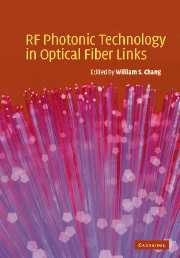Book contents
- Frontmatter
- Contents
- List of contributors
- Introduction and preface
- 1 Figures of merit and performance analysis of photonic microwave links
- 2 RF subcarrier links in local access networks
- 3 Analog modulation of semiconductor lasers
- 4 LiNbO3 external modulators and their use in high performance analog links
- 5 Broadband traveling wave modulators in LiNb03
- 6 Multiple quantum well electroabsorption modulators for RF photonic links
- 7 Polymer modulators for RF photonics
- 8 Photodiodes for high performance analog links
- 9 Opto-electronic oscillators
- 10 Photonic link techniques for microwave frequency conversion
- 11 Antenna-coupled millimeter-wave electro-optical modulators
- 12 System design and performance of wideband photonic phased array antennas
- Index
- References
4 - LiNbO3 external modulators and their use in high performance analog links
Published online by Cambridge University Press: 06 July 2010
- Frontmatter
- Contents
- List of contributors
- Introduction and preface
- 1 Figures of merit and performance analysis of photonic microwave links
- 2 RF subcarrier links in local access networks
- 3 Analog modulation of semiconductor lasers
- 4 LiNbO3 external modulators and their use in high performance analog links
- 5 Broadband traveling wave modulators in LiNb03
- 6 Multiple quantum well electroabsorption modulators for RF photonic links
- 7 Polymer modulators for RF photonics
- 8 Photodiodes for high performance analog links
- 9 Opto-electronic oscillators
- 10 Photonic link techniques for microwave frequency conversion
- 11 Antenna-coupled millimeter-wave electro-optical modulators
- 12 System design and performance of wideband photonic phased array antennas
- Index
- References
Summary
Introduction
This chapter will cover the design of modulators for high performance externally modulated analog links. This includes development of a model of the externally modulated analog link so that the connection between modulator design parameters and link performance is clear. The only type of link considered here is one using amplitude modulation of the light and direct detection.
Section 4.2 will go through the basic modulator designs in detail. Section 4.3 will relate the modulator performance to link performance, including an explanation of modulator linearization and an overview of several types of linearized modulator.
The link analysis in Section 4.3 is applicable to any externally modulated link using a modulator that can be characterized by a transfer function that depends on voltage (i.e., the optical transmission depends on voltage). It applies to modulators of any type in any material that meet this criterion. The modulator designs given in Section 4.2, and the linearized modulators described in Section 4.3.2, can be built on a variety of materials.
Lithium niobate (LiNbO3) presently is the material in widest use as a modulator substrate for modulators used in analog links. It is an insulating crystal whose refractive index changes with voltage. It has a high electro-optic coefficient, it is stable at normal electronic operating temperatures, low-loss (0.1 dB/cm) optical waveguides can be made in it, there are manufacturable ways to attach optical fibers with low coupling loss, and its dielectric constant is low enough that high speed modulators can be made without too much trouble.
- Type
- Chapter
- Information
- RF Photonic Technology in Optical Fiber Links , pp. 81 - 132Publisher: Cambridge University PressPrint publication year: 2002
References
- 10
- Cited by



